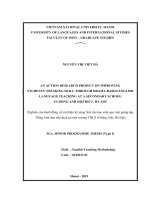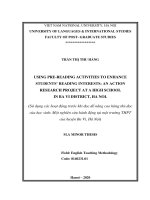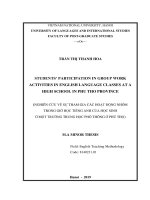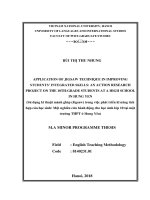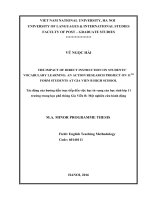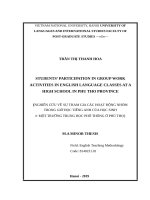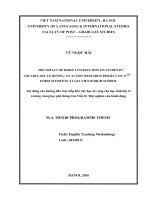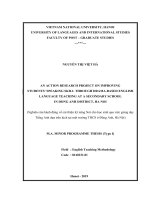An action research project on improving students’ speaking skills through drama based english language teaching at a secondary school in dong anh district, ha noi
Bạn đang xem bản rút gọn của tài liệu. Xem và tải ngay bản đầy đủ của tài liệu tại đây (1.64 MB, 98 trang )
VIETNAM NATIONAL UNIVERSITY, HANOI
UNIVERSITY OF LANGUAGES AND INTERNATIONAL STUDIES
FACULTY OF POST – GRADUATE STUDIES
---***---
NGUYỄN THỊ VIỆT HÀ
AN ACTION RESEARCH PROJECT ON IMPROVING
STUDENTS’ SPEAKING SKILL THROUGH DRAMA-BASED ENGLISH
LANGUAGE TEACHING AT A SECONDARY SCHOOL
IN DONG ANH DISTRICT, HA NOI
(Nghiên cứu hành động về cải thiện kỹ năng Nói cho học sinh qua việc giảng dạy
Tiếng Anh dựa trên kịch tại một trường THCS ở Đông Anh, Hà Nội)
M.A. MINOR PROGRAMME THESIS (Type I)
Field : English Teaching Methodology
Code : 8140231.01
Hanoi - 2019
VIETNAM NATIONAL UNIVERSITY, HANOI
UNIVERSITY OF LANGUAGES AND INTERNATIONAL STUDIES
FACULTY OF POST – GRADUATE STUDIES
---***---
NGUYỄN THỊ VIỆT HÀ
AN ACTION RESEARCH PROJECT ON IMPROVING
STUDENTS’ SPEAKING SKILL THROUGH DRAMA-BASED ENGISH
LANGUAGE TEACHING AT A SECONDARY SCHOOL
IN DONG ANH DISTRICT, HA NOI
(Nghiên cứu hành động về cải thiện kỹ năng Nói cho học sinh qua việc giảng dạy
Tiếng Anh dựa trên kịch tại một trường THCS ở Đông Anh, Hà Nội)
M.A. MINOR PROGRAMME THESIS
Field
: English Teaching Methodology
Code
: 8140231.01
Supervisor : Prof. Dr. Nguyễn Hòa
Hanoi - 2019
DECLARATION
I hereby declare that this thesis is my own work and effort and that it has not been
submitted to any other university or institution wholly or partially.
Hanoi, April 2019
Nguyễn Thị Việt Hà
i
ACKNOWLEDGEMENTS
First and foremost, I would like to express my deep gratitude to my supervisor Dr.
Nguyễn Hòa who gave me a lot of valuable guidance, encouragements, criticisms and
correction throughout my thesis writing.
I am indebted to 34 sixth grade students at DA secondary school, who provided me
with lots of useful information by answering my questionnaires.
My sincere thanks go to my family, my friends for their encouragement and support
that help me to complete my work.
ii
ASTRACT
This thesis reports the result of an action research on improving students‟ speaking
skill through drama based language teaching at a secondary school in Dong Anh
district with the help of 34 grade 6th students as research participants. The research
addressed two issues (1) the impact of drama techniques on students‟ speaking skill;
(2) the impact of drama techniques on their motivation in English lessons. The
instruments used for data collection and analysis of the study include three tests and
two questionnaires for the students, an interview with ten students to know about
difficulties and gaps of learning English speaking lessons with drama activities.
Research findings showed that drama technique was beneficial to help students
improve their speaking ability and motivate them in learning English speaking skill.
Based on the findings, some implications would be given for both the teacher and
the students. This study is expected to be a useful suggestion to both teachers and
students in teaching and learning English speaking skill.
Key words: Drama Techniques, drama activities, speaking
iii
TABLE OF CONTENTS
DECLARATION ........................................................................................................i
ACKNOWLEDGEMENTS ..................................................................................... ii
ASTRACT ................................................................................................................ iii
LIST OF TABLES ................................................................................................. vii
LIST OF FIGURES ............................................................................................... vii
LIST OF CHARTS ................................................................................................ vii
CHAPTER 1: INTRODUCTION ........................................................................... 1
1.1. Rationale for the study ......................................................................................... 1
1.2. Aims of the study ................................................................................................. 2
1.3. Research questions .............................................................................................. 2
1.4. Methods of the study ........................................................................................... 2
1.5. Significance of the study ..................................................................................... 3
1.6. Scope of the study ............................................................................................... 3
1.7. Structure of the thesis ........................................................................................... 3
CHAPTER 2: LITERATURE REVIEW ............................................................... 5
2.1. Speaking skill ....................................................................................................... 5
2.1.1. Definition of speaking ....................................................................................... 5
2.1.2. The Importance of Speaking Skills ................................................................... 6
2.1.3. The Components of Speaking Skill .................................................................. 7
2.1.4. Characteristics of Successful Speaking Activities ............................................ 8
2.1.5. Communicative Language Teaching (CLT)...................................................... 9
2.2. Drama technique ................................................................................................ 10
2.2.1. Definition of “drama activities” ...................................................................... 10
2.2.2. Theoretical framework .................................................................................... 11
2.2.3. The benefits of using drama activities in EFL class ....................................... 12
2.2.4. Teacher and student role ................................................................................. 16
2.2.5. Common types of drama activities .................................................................. 17
iv
2.3. Previous Studies ................................................................................................. 22
2.4. Summary ............................................................................................................ 23
CHAPTER 3: METHODOLOGY ......................................................................... 25
3.1. Research questions and context of the study ..................................................... 25
3.1.1. Research questions restated ............................................................................. 25
3.1.2. Context of the study ........................................................................................ 25
3.1.3. Participants ..................................................................................................... 26
3.2. Design of the study............................................................................................. 26
3.3. Instruments ......................................................................................................... 29
3.3.1. Pre- test and post- test (Appendix 2, 3, 4) ....................................................... 30
3.3.2. Questionnaire (Appendix 8) ............................................................................ 30
3.3.3. Interview ......................................................................................................... 32
3.4. Procedure ............................................................................................................ 32
3.4.1. Cycle 1 ............................................................................................................ 32
3.4.2. Cycle 2 ............................................................................................................ 33
3.5 Data analysis ....................................................................................................... 34
3.6. Summary ............................................................................................................ 34
CHAPTER 4: FINDINGS AND DISCUSSIONS ................................................. 35
4.1. Findings and discussions for the research question 1 “What impact do drama
techniques have on students‟ speaking skills? .......................................................... 35
4.1.1. Data collected from the pre-test and post –test in the first cycle (Appendix 6) ... 35
4.1.2. Data collected from the post –test in cycle 2 (Appendix 6) ............................ 36
4.1.3. Data collected from questionnaire with students about their speaking skill
self- evaluation. ......................................................................................................... 37
4.1.4. Data collected from interview with students about their speaking skill selfevaluation. ................................................................................................................. 40
4.2. Findings and discussions for the research question 2 “What impact do drama
techniques have on students‟ motivation? ................................................................ 41
4.2.1. Data collected from questionnaire with students about their attitudes towards
the use of Drama Activities in their English Speaking lessons. ............................... 41
v
4.2.2. Data collected from interview with students about their attitudes towards the
use of Drama Activities in their English Speaking lessons.(see Appendix 9) ............ 46
4.3. Summary ............................................................................................................ 48
CHAPTER 5: CONCLUSION ............................................................................... 48
5.1. Recapitulation .................................................................................................... 49
5.2. Conclusion .......................................................................................................... 49
5.3. Limitations ......................................................................................................... 50
5.4. Recommendation................................................................................................ 51
5.4.1. Recommendation for teachers ......................................................................... 51
5.4.2. Recommendation for students ......................................................................... 52
5.5. Suggestions for further research......................................................................... 53
REFERENCES ........................................................................................................ 54
APPENDICES ........................................................................................................... I
APPENDIX 1A: LESSON PLAN .............................................................................. I
APPENDIX 1B: LESSON PLAN FOR TOPIC 1: MY NEW SCHOOL ................ III
APPENDIX 2: PRE-TEST FOR STUDENTS ..................................................... VIII
APPENDIX 3: POST- TEST 1 FOR STUDENTS ................................................. XI
APPENDIX 4: POST- TEST 2 FOR STUDENTS ............................................... XIII
SPEAKING TOPIC CARD 1 ................................................................................ XIII
APPENDIX 5: SPEAKING ASSESSMENT CRITERIA CARD .......................... XV
APPENDIX 6: STUDENTS‟ SCORE IN PRE-TEST AND
POST-TEST IN
CYCLE 1 ................................................................................................................XVI
APPENDIX 6: STUDENTS' SCORE IN POST-TEST IN CYCLE 1&2 ........... XVII
APPENDIX 6: STUDENTS' SCORE IN PRE-TEST AND POST-TEST ......... XVIII
APPENDIX 7: PRE-SURVEY QUESTIONNAIRE FOR STUDENTS................ XX
APPENDIX 8: POST - SURVEY QUESTIONNAIRE FOR STUDENTS IN .. XXV
APPENDIX 9: INTERVIEW GUIDE WITH STUDENTS ............................ XXVIII
APPENDIX 10 ....................................................................................................XXIX
vi
LIST OF TABLES
Table 4.1: The results of the pre- test and post- test in cycle 1 ................................. 35
Table 4.2: The results of the post- test in cycle 2 ..................................................... 37
Table 4.3: The language skills have been improved by the students ........................ 39
Table 4.4: Students‟ opinion of the applying Drama activities ................................ 42
Table 4.5: Students‟ opinion of the continuing working with Drama activities and
situations.................................................................................................................... 44
Table 4. 6: Students‟ suggestions for the teacher in the class ................................... 45
LIST OF FIGURES
Figure 2.1. Action research cycles ( Kemmis & Mc Taggart, 1988) ........................ 27
Figure 2.2.Action research cycles (Kemmis & McTaggart, 1988, cited by Burn
2010).......................................................................................................................... 27
LIST OF CHARTS
Chart 4.1: Compare the results of the pre- test and post – test in cycle 1 ................. 36
Chart 4.2: Compare the results of the tests in both cycle 1 and 2 ............................. 37
Chart 4. 3: You can speak English better through this style learning ....................... 38
Chart 4.4: Pronunciation, lexical resource and grammatical range have improved by
the students ................................................................................................................ 40
Chart 4.5: Students‟ opinion of learning English through Drama activities ............. 41
Chart 4.6: Students‟ opinion of the applying Drama activities ................................. 43
vii
CHAPTER 1: INTRODUCTION
1.1. Rationale for the study
Speaking may be the most important and interesting component of any
language. It represents the most natural and common form of communication
among humans. We can easily say that people speak more than they write, so
speaking is also probably the main goal for anyone studying a foreign language.
Despite so, it can be often obstructed by a series of factors, such as shyness, lack of
self-confidence, fear of other people‟s judgment, laziness, and so forth. Sometimes
it is not simple to overcome such difficulties people may have with oral
communication in a foreign language and this can often lead to stress,
discouragement and lack of interest in learning.
Having been teaching English for several years at a secondary school, I have found
that most of my students make not so much progress in their learning English,
especially speaking. Students seemed to use their first language most of the time,
making little or no effort at all when practicing their speaking skills. Also, they felt
embarrassed and contained from speaking in front of their mates, showing
annoyance, bother and no collaboration, especially, students in grade 6 because they
do not have enough lessons to practice speaking English in the class.
How to improve speaking skills for students becomes my biggest concern. I always
try to find out the best ways to encourage my students to learn English better and be
confident to speak English in and outside the classroom.
I have read many books and articles about advantages of using drama activities in
teaching English. I have found many researches in our country and in the world
about using drama techniques on improving students‟ Speaking English skill. I
myself took part in a Teaching English through drama course offered by Professor
Dr. Gary B. Carkin at the Post Graduate Office of the University of Languages and
International Studies, Vietnam National University last year. This 11 day course
was useful for me. The course led participants through the various approaches and
1
techniques involved in drama education, illuminating how the four skills can be
taught through drama based activities, especially speaking skills.
I thought, I could try to do a research on using drama based language teaching to
improve the sixth-grade-students‟ speaking skills at a secondary school. I want to
investigate the ways that Drama activities enhance students‟ speaking skill and
motivation in the EFL secondary classroom.
1.2. Aims of the study
The research aims to:
-discover how the use of drama techniques in teaching English helps improve
students‟ English speaking skill.
- find out the sixth-grade students‟ attitudes towards the use of drama techniques in
their English speaking lesson.
1.3. Research questions
The study will be guided by two research questions below:
1. What impact do drama techniques have on students‟ speaking skills?
2. What impact do drama techniques have on students‟ motivation?
1.4. Methods of the study
- Reason for use action research
I will adopt the action research to conduct the study for the reason that “action
research is a form of investigation designed for use by teachers to attempt to solve
problems and improve professional practices in their own classrooms. It involves
systematic observations and data collection which can be then used by the
practitioner- researcher in reflection, decision-making and the development of more
effective classroom strategies. (Parsons and Brown, 2002).
- Action research design
This study will be carried out with two reflective cycles adopted from Kemmis and
McTaggart (1990) that includes following process: plan, action, observe and reflect.
-Instruments
The tools for data will be combined three instruments: tests (a pre-test, a post- test),
a questionnaire and an interview for students.
2
The pre- test and post- test will be designed to measure and compare students‟
language skill (especially speaking skill) before and after the intervention of drama
technique.
The questionnaire and interview will be used to find out the 6th –grade – students‟
attitudes towards the use of Drama Activities in their English Speaking lessons. The
questions will be grouped into four blocks, each reflecting a different aspect to be
valued: the intrinsic motivation, the extrinsic motivation, a students‟ self- evaluation
about their language skills and the methodology employed within the classroom.
1.5. Significance of the study
As a practitioner, I am expected to be able to answer the research problems of the
study. Mostly important, the researcher intends to discover something to learn by
conducting action research (AR). In addition, I am also expected to be a creative
and innovative English teacher in organizing classroom activities in speaking class
so that the students can achieve the communicative competence.
I also hope that this study can be useful for the further studies. The result of this
study can be applied by the other researchers in the same topic as their reference for
the sake of better improvement of a classroom practice.
1.6. Scope of the study
The research only focuses on using drama techniques on improving the sixth- grade
students‟ speaking skills at a secondary school in the first term of the school-year of
2018-2019.
1.7. Structure of the thesis
Chapter 1: Introduction presents the rationale, aims, methodology, significance and
scope of the study.
Chapter 2: Literature review - It includes four parts. The first one focuses on the
theoretical descriptions about speaking skill, the importance of speaking skill,
characteristics of Successful Speaking Activities and communicative language
teaching. Definition of drama activities, the theoretical framework, benefits of using
drama activities, common drama activities in EFL classroom are given in the second
one. The last one is about Previous Studies in the world and in Vietnam
3
Chapter 3: Methodology - in this chapter, the introduction of research method
including research questions, data collection instruments, data collection procedure
and data analysis are presented.
Chapter 4: Findings and discussions – helps to classify the effectiveness of Drama
activities on improving students‟ speaking skill and motivation at EFL secondary
classroom. In addition, not only good points but also weak points and solutions are
clearly shown.
Chapter 5: Conclusion, which is the last chapter, followed by references is the
summary of the whole study. The limitation of the study and suggestion for further
studies are also recommended.
4
CHAPTER 2: LITERATURE REVIEW
This chapter aims at providing readers the theoretical descriptions about speaking
skill, the importance of speaking skill, characteristics of Successful Speaking
Activities and communicative language teaching. In addition, background
information about Drama technique and preceding studies will be displayed
specifically.
2.1. Speaking skill
2.1.1. Definition of speaking
There are a lot of definitions of speaking. According to Webster (1980), speaking
has a variety of meanings: a. to tell, to say, to make known or as by speaking, to
declare; to announce. b. to proclaim, to celebrate. c. to use or be able to use (a given
language) in speaking.
Byrne (1986) stated that, “oral communication (or speaking) is a two way process
between speaker and listener and involves the productive skill of speaking and the
receptive skill of understanding”. Based on the previous four definitions, it can be
synthesized that speaking is the process of sharing with another person, or with
other persons, one‟s knowledge, interests, attitudes, opinions or ideas. Delivery of
ideas, opinions, or feelings is some important aspects of the process of speaking
which a speaker‟s idea become real to him and his listeners.
In 1999, the definition of speaking was defined by Nunan as:
“Speaking is an interactive process of constructing meaning that involves
producing, receiving and processing information. Its form and meaning are
depending on context in which occurs, including the participants themselves, their
experiences, the physical environment, and the purposes for speaking. It is often
spontaneous, open-ended, and evolving. However, speech is not always
unpredictable. Speaking requires that learners not only know how to produce
specific points of language such as grammar, pronunciation, or vocabulary(
“linguistic competence”), but also that they understand when, why, and in what
ways to produce language (“sociolinguistic competence”)”. (Nunan, 1999).
5
From these definitions of speaking, I adopted the definition of speaking from Nunan
for my research. I wish, drama activities helped my students not only how to
produce specific points of English such as grammar, pronunciation, or vocabulary,
but also that they understand when, why and how to use English in real
communication.
2.1.2. The Importance of Speaking Skills
Language skill separates into two kinds that are receptive and productive. Receptive
consists of listening and reading skills. Productive consists of speaking and wring
skills. All of the skills are important in communication, including English
communication. That is how the four skills are taught in English as a Foreign
Language (EFL). One of the most important skills in EFL is speaking skill.
Speaking has acquired great importance since it is referred as an interactive process
of constructing meaning that involves producing, receiving and processing
information (Brown, 1994; Burns & Joyce, 1997). English has become primordial
worldwide for it has become a lingua franca. Therefore, it is the main source for
communicating in many fields.
Richards (1990) states that the mastery of speaking skill in English is seen as a
priority for many EFL learners across the world. Moreover, he adds that learners
consequently often evaluate their success in language learning as well as the
effectiveness of their English course based on how well they feel they have
improved in their spoken language skill.
Speaking is the action of conveying information or expressing one's thoughts and
feelings in spoken language. From the definition, it concludes that speaking is
expression in sending messages from a speaker towards listeners.
Speaking is one of four language skills in English which demanding the speakers to
be productive to produce oral words and phrase into a sentence which finally can
make people to communicate. Speech plays a great role in our daily lives. Through
6
speech we can express our feelings, ideas and points of view to others. In
classrooms especially where second or foreign languages are taught the main thing
for most of the students are to speak fluently with the target language.
Speaking skill is an interactive process of constricting meaning that involves
producing
and
processing
information.
The
speaking
skill
involves
a
communicative ability to use language to chat and transmit messages in different
and appropriate situations. That is to say speaking is an important skill which
deserves more attention in both first and second language because it reflects
people‟s thoughts and personalities.
Teaching speaking is a very important part of second language learning. The ability
to communicate in a second language clearly and efficiently contributes to the
success of the learner in school and success later in every phase of life.
In short, speaking is one of the important skills in English as a Foreign Language
(EFL). By the importance of speaking, the goal of English teaching is to make
students able to communicate well.
2.1.3. The Components of Speaking Skill
According to Syakur (1987), there are at least five components of speaking skill
concerned with comprehension, grammar, vocabulary, pronunciation, and fluency.
- Comprehension. For oral communication, it certainly requires a subject to respond,
to speech as well as to initiate it.
- Grammar. It is needed for students to arrange a correct sentence in conversation. It
is in line with explanation suggested by Heaton (1991) that students‟ ability to
manipulate structure and to distinguish appropriate grammatical form in appropriate
ones. The utility of grammar is also to learn the correct way to gain expertise in a
language in oral and written form.
- Vocabulary. One cannot communicative effectively or express their ideas both oral
and written form if they do not have sufficient vocabulary. Without grammar very
little can be conveyed, without vocabulary nothing can be conveyed (Willid, 1990).
So, based on this explanation, the researcher concluded that without mastering
vocabulary sufficiently is English learners will not be able to speak English or write
7
English properly.
-Pronunciation. Pronunciation is the way for students‟ to produce clearer language
when they speak. It deals with the phonological process that refers to the component
of a grammar made up of the elements and principles that determine how sounds
vary and pattern in a language. There are two features of pronunciation; phonemes
and suprasegmental features. A speaker who constantly mispronounces a range of
phonemes can be extremely difficult for a speaker from another language
community to understand (Gerald, 2001). From the statement above, the researcher
concluded that pronunciation is the knowledge of studying about how the words in a
particular language are produced clearly when people speak. In speaking,
pronunciation plays a vital role in order to make the process of communication easy
to understand.
-Fluency. Fluency can be defined as the ability to speak fluently and accurately.
Signs of fluency include a reasonably fast speed of speaking and only a small
numbers of pauses. Fluency refers to the ease and speed of the flow of the speech
(Harris, 1974). Fluency is the smoothness or flow with which sounds, syllables,
words, and phrases are joined together when someone speaks. When a person
makes a dialogue with another person, the other person can give respond well
without difficulty.
For example, A asks B: “How are you today?” B answers: “I am fine, thank you.”
It is answered well and quickly.
2.1.4. Characteristics of Successful Speaking Activities
Sometimes spoken language is easy to perform, but in some cases, it is difficult
(Pollard, 2008). In order that students can carry out the successful speaking, they
have to fulfill some characteristics of successful speaking activity below.
According to Ur (1996), students should have chances to talk a lot using the target
language. What is difficult to achieve, although still possible, is the desire to have
the time devoted to such an activity filled with learner talking time to the maximum.
What a teacher can do to promote speaking is to divide students into groups.
8
Working in groups increases the amount of practice learners can get, as well as the
amount of their speaking. When students sit in a small circle, their inhibitions are
lowered and thus they are encouraged to speak.
Another feature of a successful speaking activity, pointed by Brown (2001) is even
participation. All students should get a chance to speak; moreover, contributions
ought to be fairly evenly distributed. Therefore, teachers‟ task is to strive towards
engaging the less active learners and make sure that all students are involved in an
equal way.
Dobson (1989) suggests that in order to make sure that every learner has a
possibility to practice the target language, the teacher can appoint a group
representative responsible for equal participation among peers.
Motivation also plays an important role in a successful lesson devoted to speaking.
Without showing a genuine concentration on performing a task, the class faces no
efficiency. There are two main kinds of motivation: intrinsic motivation and
extrinsic motivation.
According to Harmer (2001), “extrinsic motivation is caused by any number of
outside factors, for example, the need to pass an exam, the hope of financial reward,
or the possibility of future travel.” A student feels obliged to acquire a language
because outside factors motivate him or her to learning. The second kind of
motivation − intrinsic motivation, on the contrary, stands in total contrast to
extrinsic one since it comes from within the person. (Harmer, 2001).
The last but not least important principle, mentioned by Ur (1996), is the acceptable
level of the language used. An educator can achieve it by selecting activities whose
language level is similar to students‟ linguistic level. Such oral tasks empower
students and give learners the possibility to clearly express their ideas and opinions
through fluent speech.
2.1.5. Communicative Language Teaching (CLT)
Setiyadi (2006) defines communicative language teaching (CLT) as an approach that is
9
regarded to make the communicative competence the goal of language teaching.
CLT also develops procedures for the teaching of the four language skills that
acknowledge the interdependence of language and communication (Setiyadi, 2006).
Accordingly, the language learners are supposed to be able to use language in
communication (Efrizal, 2012; Richards, 2005; Setiyadi, 2006; Wardhaugh, 1997).
The language teaching itself is contextualized by presenting language items in
situational settings.
In other words, whatever the contextualization the teacher provides will facilitate
the language learners to learn the communicative function of the language.
In order to achieve the communicative competence, CLT is often strongly
associated with a number of particular classroom activities that do not make the
language learners fall asleep during learning language (Efrizal, 2012; Setiyadi 2006)
such as problem-solving and pair work.
CLT basically sets as its goals the teaching of communicative competence
(Richards, 2005). The communicative competence includes aspects of language
that require language learners to know how to use language for a range of different
purposes and functions, how to vary our use of language according to the setting
and the participants, how to produce and to understand different types of texts, and
how to maintain communication despite having limitations in one‟s language.
The English text book for grade 6 follows this approach. It was written and
designed with a purpose to developing students‟ communicative skills at basic level:
speaking, listening, reading and writing as well as supporting students with
appropriate, systematic and basic knowledge of English. I used drama technique and
found that it was an effective way to help students to improve their communicative
competence.
2.2. Drama technique
2.2.1. Definition of “drama activities”
Susan Holden (1981) defines drama as any activity which asks the participant to
portray himself in an imaginary situation; or to portray another person in an
10
imaginary situation. Drama is thus concerned with the world of 'let's pretend'. It
provides an opportunity for a person to express himself through verbal expressions
and gestures using his imagination and memory.
According to Shand (2008), "educational drama and Second Language Instruction
educational drama refers to using creative drama techniques to teach other subjects.
These techniques include, but are not limited to pantomime, storytelling, story
dramatization, role-playing, improvisation, theatre games, process drama, and play
production."
To quote Gavin Bolton (Dougill J. 1987), "drama is a unique tool, vital for language
development” as it simulates reality and develops self -expression. You need not go
into a full-fledged production and public performance. You could begin with
incorporating one-off and stand-alone drama activities stretching as less as five
minutes in your class where students perform for each other. Drama activities or
techniques are equally successful in making learners experience language in
operation and provide motivation to use language embedded in a context and a
situation. The simple "acting- out" requiring the learners to adopt a new position
involves them creatively.
In this study, drama refers more to informal drama (creative dramatics) as it is used
in the language classroom and not on stage. The participants in the drama activities
are thus learners and not actors.
Before starting to analyze the advantages and disadvantages of using in a language
classroom, I will briefly discuss the methodology which represents the theoretical
foundation of drama techniques.
2.2.2. Theoretical framework
With respect to the methodological principles, drama techniques are based on the
Communicative Approach.
Larsen-Freeman (1990) remarks, the principal goal of such approach is not focused
on the linguistic accuracy, but rather on making the students communicate in the
target language fluently. The language produced in the classroom is employed
11
within a social context and it is appropriate to the specific participants, setting and
topic. As a consequence, the communication has a purpose and is meaningful, as it
is “sociolinguistically appropriate” (Larsen-Freeman, 1990). Students are involved
in pair and group activities, where they have the opportunity to dedicate more time
to speaking interaction with their peers and negotiate meaning in order to be
understood. The groups are constantly exchanged so that the pupils have the chance
to know each other better and increase their confidence. The teacher does not direct
the activities, but he or she acts as a facilitator of the learning process, since the
student is the true protagonist and the lesson is learner- centred. Also, according to
this approach, students are given the opportunity to express their feelings and
opinions. Finally, grammar mistakes are tolerated, since communication and
fluency are given a main role. The teacher can correct students‟ errors afterwards,
trying not to interrupt the normal flow of a conversation.
After having outlined the theoretical framework of dramatic techniques, I analyze
the benefits of using drama activities in a language classroom context.
2.2.3. The benefits of using drama activities in EFL class
Smith (1984) noted, although drama has existed as a potential language teaching
tool for hundreds of years, it has only been in the last thirty years or so that its
applicability as a language learning technique to improve oral skills has come to the
forefront. Below, I am going to show some of the most remarkable benefits of
drama activities in EFL classes.
2.2.3.1. Motivation
Among the numerous benefits of using drama activities in a classroom, a lot of
scholars believe they are entertaining, fun and useful to motivate students learning.
(Dougill, 1987; Livingstone, 1985; Maley and Duff, 1982; Philips, 2003).
Maley and Duff (1982) focus on the connection between drama and student motivation
and they say that “ if drama is motivating- and we believe it is – the reason may be that it
draws on the entire human resources of the class and that each technique, in its own way,
yield a different, unique, result every time it is practiced”.
12
Gaudart (1990) asserts that drama techniques help teachers to organize the class
well and to engage all the students more actively in the English learning process.
Using drama activities in the classroom will not only change the atmosphere of the
learning process, but it will bring more enthusiasm among the learners.
Drama can help students to overcome the psychological barrier from speaking in a
foreign language because it is a kind of stress-free, fun teaching that encourages
pupils to participate without embarrassment”. (Hamilton & Mcleod, 1993).
Drama motivates students to speak. Students with low proficiency and low
confidence can be benefited from drama, just like “good” students. Hamilton &
McLeod also state that drama provides students with a broad range of opportunities
in learning English and drama motivates them to learn speaking and give them more
confidence to speak English (Hamilton & Mcleod, 1993).
Guida (1995) shows that drama can also bring motivation to less confident students
to speak up before the class “even some students who do not have confidence to
speak up in public are willing to join in the drama activities. They have a lot of fun
and become creative and often able to speak naturally”.
In addition, the teaching language through drama can make the students are pleasant
and enjoyable when they learn. They need to move physically while they are
speaking, because that is also what they normally do in a normal conversation.
They feel more interested and stimulated if they are given a friendly environment
where they can “take risks in the language” occasionally, because it is also a way of
experimenting their language knowledge and discovering their gaps. (Maley and
Duff, 1982)
Research of Greenfader (2013) supports that a drama can help the learners
understand the lesson easily than the traditional instruction.
“By using drama techniques to teach English, the monotony of a
conversational English class can be broken and the syllabus can be
transformed into one which prepares learners to face their immediate world
better as competent users of the English language because they get an
13
opportunity to use the language in operation.” (Chauhan, 2004)
2.2.3.2. Communication
Drama techniques and activities to develop communication skills through fluency,
pronunciation, cooperative learning, confidence building and intercultural
awareness may be added also to the above mentioned elements.
Using drama activities in the classroom is a good vehicle for learners to develop
their own performance skills. Through these techniques, teachers provide learners
with appropriate knowledge, understanding and skills to make progress in their
learning process, and make the teaching of the target language more efficient.
Learners are provided with opportunities that help them focus not only on language,
but also on the learning process itself.
Drama is authentic, it can be used in real conversation, where students can express
their emotions and ideas while listening to the feelings and ideas of their classmates.
(Aldavero, 2008)
In addition, drama can give the opportunity to communicate with other people in the
classroom because it helps the language skills of learners such as speaking and
listening skills. When the students talk to each other during the show, the learner
can exchange and share their knowledge together. The learners can gain new
information through using drama.
Furthermore, drama activities provide a variety of different functions of language, since
they reproduce real situations, so students are introduced into an authentic
communication context. In fact, drama in the educational field” consists in fostering the
social, intellectual and linguistic development” of the student. (Dougill, 1987)
Moreover, drama activities allow the students to show his or her own feelings,
personality and creativity, ( Maley and Guff, 1982) to be used in the language class.
Maley (2005) told that the drama can give learners a new experience of using the
language for communication.
Drama
has
a
significant
function
especially
in
specifically
improving
acquired/improved speaking skills among the basic language skills. Drama helps
14
students‟ speaking more emotional and fluent. Dramatizing also allows students to
express their emotions, thoughts and feelings, which can vary depending on the
communicative situation (Fleming, 2006).
Gomez finds that steps by steps, drama can help students enhance their speaking
skill more emotional, accurate and fluent by learning syntax and fundamentals then
sounds and idioms (Gomez, 2010).
2.2.3.3. Meaning in Context
The possibility of employing language in context is another benefit of using drama
activities in EFL classroom. In fact, in the classroom students are often exposed to
small bits of language, such as individual words, sounds, rather than whole phrases
or situations (Phillips, 2003). When speaking, they are not always “asked to
combine the different structures they are learning” (Phillips, 2003, p.8), so drama
leads students to make an effort, by employing a huge variety of language structures
and functions, in order to have a successful communication.
Desiatova (2009) confirms that students can learn a foreign language through drama by
constantly interpreting meaning from a context, using their previous knowledge in a
creative way, interacting with each other and working with imagination and fantasy.
Drama activities help to reinforce language previously learned. It helps learn new
vocabulary and expressions in their real environment. When using drama in the
classroom they will help learners extend, retain and reinforce vocabulary and the
structures of sentences. The latter can be achieved through the use of role-plays and
communication games. Drama activities encourage students‟ imagination and make
the process of learning more meaningful and realistic (Sam, 1990).
Drama can motivate learners to guess the meaning of unknown words in their action
in a context. It can help the learners gain the confidence and pride of using the
language spontaneously.
As a result of the study of Miccoli (2003) shows that the students can learn
vocabulary, pronunciation and the language accent of the language. The learners
trust themselves more than before.
15
Furthermore, according to Wasanasomsithi (2009) explains that drama is useful of
speaking development and the drama techniques help the learners can conduct and
clarify their thoughts.
From the test of Araki-Metcalfe (2012) illustrates that the students will gain a new
knowledge from the inquiry-based learning and find a new way of communicating
with other learners. The learners can develop a consciousness of their own
knowledge through using drama. They are active in learning a new process.
In summary, from many researches, I believe that using drama activities in teaching
has many useful for the EFL students. Next, I want to analyze the teacher- student
relationship and their respective role in the success of using drama activities in EFL
classroom.
2.2.4. Teacher and student role
According to Maley and Duff (1982), the teacher and students should follow some
basic rules such as:
students should suspend their judgment during the whole activity;
the teacher has to be as clear as possible and give precise instructions, so that
students know which group they belong to, who their partners are and what they are
expected to do;
materials, such as photocopies, pictures, objects, etc. have to be provided;
the teacher should walk round the classroom and keep a close control;
the teacher has to decide how much he or she is going to intervene during the
activity.
Fleming (2006) claims that drama is definitely learner-centered, since it would not
work without students‟ active cooperation. Moreover, it creates “a need to learn the
language, either through use of creative tension, or by putting more responsibility
on the learner, as opposed to the teacher” (Ulas, 2008).
The teacher has to be clear and sure that the students understand what they have to
do, then he or she has to step back and let them be the real protagonists of the
activity, “controlling but not directing” (Maley and Duff, 1982).
16
